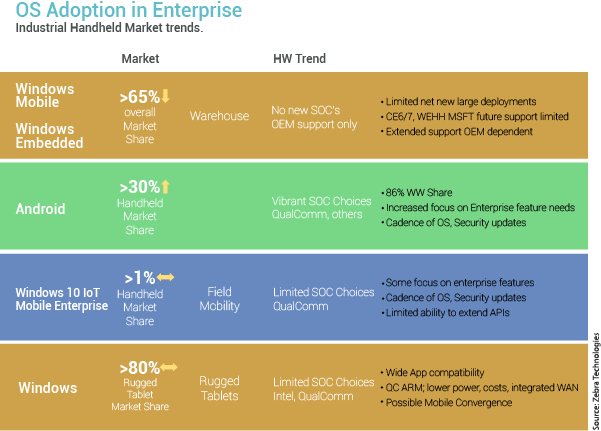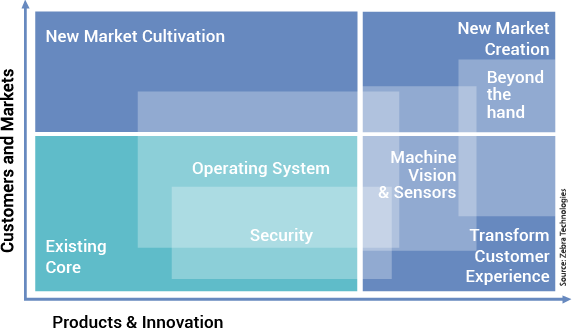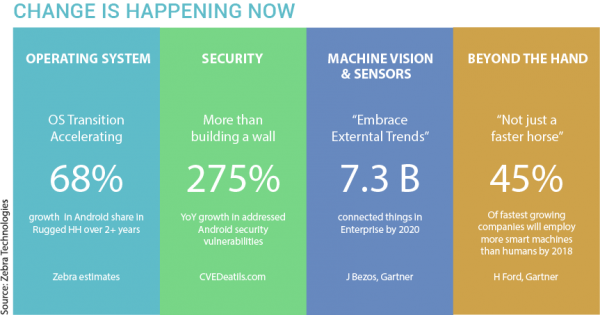White Paper | Evolving Trends in Rugged Mobile Computing
Evolving Trends in Rugged Mobile Computing
Author: 42Gears Team
INTRODUCTION
As time progresses, new technologies continue to reshape the retail and logistics industry. Multi-channel retailing and ever-increasing customer demands are forcing retailers to make significant investments in technology. As retailers are usually not technically savvy, they look at partners to help them with the necessary tools, infrastructure and technological capabilities in order to fulfill business operational needs. This paper describes the pre-Android rugged handheld landscape, where Windows-based rugged devices were the market leaders, followed by a period of platform fragmentation and proprietary development, resulting in the growth of Google Android platform since 2013, which tremendously impacted the rugged device space. The paper also looks at the way companies approach enterprise mobility related investments.
THE DARK AGE
It’s been almost two decades since retail companies started using ruggedized handheld computers and rugged PDAs as point-of-sale, inventory management and customer shopping solutions. Most of these handheld computers were based on Microsoft operating systems, either Windows CE or Windows Mobile (essentially a friendlier user interface on top of Windows CE). Most of these applications are still quite successful and are being used in the industry.
Around 2011, with the advancement in technology, the evolution of feature-rich Smartphones revolutionized the replacement of traditional PDA/Pocket PC by smartphones based on Apple's iOS or Google's Android operating system. Regardless of these developments, until 2007 virtually all rugged handhelds were still built on Windows platform.
While consumer electronics has been continuously changing since 2000, industrial handheld computers have had a much longer life cycle. Many models in use have remained almost unchanged for several years, with importance being emphasized on their ruggedness and convenience rather than fancy looks and features.
However, with the evolving technical landscape, new operating systems, security issues, increasing customer demands and market pressure, there is a change in the way how handhelds are being used, forcing the handheld OEMs to develop new products.
Handheld devices are used everywhere, by delivery personnel, warehouse workers, shop clerks, banking staff and emergency responders. Usually equipped with scanners, the devices can be used to manage inventory, receive orders and confirm delivery.
For many years now, most rugged devices that serviced the supply chain industry have run on a version of the Windows Embedded operating system. By 2013, it had more than 80 percent of the enterprise market. But, industry experts are now predicting a change within the next five years that will see companies using Windows based rugged devices shift to Android OS. This could prove to be one of the biggest industry platform shifts ever.
INTRODUCTION TO THE 'PARADIGM SHIFT'
In 2013, it became increasingly clear that Android was considered a feasible alternative for rugged handhelds. Some manufacturers began offering Android versions of selected handhelds, often with the same or similar hardware as their Windows Mobile based products. Both Intermec and Motorola started building devices based on Android platforms. Also on the software side, cross-platform solutions such as RhoMobile and iFactr started fuelling easier transition by enabling apps that ran on multiple OS platforms.
Rugged hardware manufacturers have started adding new features to work with new emerging operating systems such as faster processing speeds, increased storage and memory, bigger displays and touchscreens.
By 2014 more new legacy handhelds with versions of Windows CE or Windows Embedded Handheld were launched, but there were at least a matching number of new Android-based handhelds developed by new device manufacturers.
Till 2015, most manufacturers of rugged handheld devices sold both Android and Windows devices. But , the majority still sold Windows Embedded Handheld 6.5, primarily due to the lack of a feasible alternative from Microsoft.
Some interesting trends captured were -
a) Wider acceptance of capacitive multi-touch instead of the resistive touch that had ruled handhelds for almost two decades
b) Rapidly increasing display sizes to meet the demands of customers used to giant smartphone screens.
In 2017- Windows 10 IoT versions started gaining traction. But due to its extensive features, there is a steady increase in demand for Android based mobile devices. The Windows/Android battle for industrial and vertical markets has now tilted quite decisively in Android's favor.
Also the evolution of HTML 5, allowed effective cross-platform application development so that is not locked to a specific mobile OS. With HTML5, companies can support different devices for different uses on the same application, without having to worry about device interoperability. In addition to the cross-platform functionality, HTML5 also lets provides other enhancements, like smarter form controls, APIs, database support, faster processing, and memory.
Some new technologies like RFID, GPS, wireless radios, high quality imagers and scanners, sensor technology and integrated high-resolution cameras were also in demand. Though these features aren’t new, they are being utilized effectively only recently through integration into android based-handhelds.
Why is Windows Embedded Expected to Lose the Industry Race?
Windows Embedded CE version 6 first debuted in 2006 and managed to capture a large portion of the embedded device market. Later on, Windows Embedded Handheld 6.5 became the most successful mobile OS with Windows Embedded 7 and Windows Embedded 8 getting almost totally ignored. It is expected that the new Windows IoT will also probably face a similar reaction.
The fact that Windows Embedded Version 8 and above OS are incompatible with Version 7 and earlier makes it all the more difficult for enterprises to migrate to newer operating systems. Also, Windows Embedded 8 didn't offer support for all screen sizes and form factors, making it unsuitable for specialty devices. More importantly, chipset vendors stopped supporting Windows OS.
Microsoft’s announcement that it’s ending extended support for Windows Embedded 6 in in 2017 and Windows Embedded 7 in 2020 effectively puts an end to almost 2 decades of handheld device convenience. Going forward developers and device manufacturers will be required to rewrite their apps to a new operating system.
For any company, making the transition will come at a cost and will be time consuming. Especially in the retail sector, where dozens of specialty-device apps are used, the transition to become compatible with a newer version of Windows can include a cost worth millions of dollars. With such a huge investment, companies will be looking at ensuring that the new platform is not only comfortable to adopt but also has a strong future. As a result, many large retail enterprises like Home Depot have now moved on to Android.

WINDOWS VS ANDROID OS FOR RUGGED HANDHELDS
An interesting new development in rugged handheld category, which is driving Android preference, is the inclusion of increasingly sophisticated sensor technology. Motion sensors, pioneered in smartphones, can be used to automatically change display orientation, engage power conservation, or interact with applications. Light sensors can adjust screen brightness to save battery power.
- While comparing user interface of both the Operating Systems, Android has better interface than Windows. Android provides pre-built structured layout objects as UI components and UI controls to build graphical user interface for apps. For special interfaces such as menus, dialogs and notifications, Android provides UI modules as well.
- As Android is popular in the consumer market, most of the employees are familiar with its user interface. High user familiarity can reduce confusion and learning time, making training easier and saving cost. Whereas, Windows mobile devices are comparatively less popular among consumers and require specific knowledge know-how to work through devices.
- Android runs each application in individual sandbox containers ensuring data protection between processes. On the other hand, Windows Embedded implements monolithic memory layout for running processes where it is possible for one application to access/modify data for other applications.
- Android provides better APIs for EMM solutions than Windows. The latest upgrades of Android includes remote wipe capabilities, applications whitelisting and blacklisting and encryption.
- Huge apps catalogue available on Android Play Store allows easy access to business applications. But there is nothing comparative available for Windows Embedded devices.
- Creating an embedded system requires a vast open source code library and a stable kernel. Android provides this with no royalties and license fees, allowing developers and manufactures to access them easily. Also, it is more expensive to put an app on the Microsoft app store for Windows devices compared to Android Play Store.

CURRENT MARKET SCENARIO
Some of the biggest market leaders offering rugged handhelds include Zebra, Honeywell, Intermec, Motorola and Datalogic.
Intermec was acquired by Honeywell in 2013. Honeywell is focusing on the development of cross platform Handheld Computers. The Honeywell CN75 and CN75e mobile computers provides the choice of a Windows or Android operating system on a single device to meet changing enterprise business demands.
While Datalogic is committed to extend its support to Windows CE6/WEC 7 and Windows Embedded Handheld 6.5 (WEHH 6.5) till 2022, it has also started developing Android based mobile computers in 2015. It's DL-Axist™ PDA is a rugged full touch Enterprise Class PDA with Android technology and a brilliant display.
Zebra is the market leader in Enterprise mobile computing and has 42% rugged market share. It offers a wide range of handheld computers that cater to healthcare, mobile, logistics, and retail professionals, offering immediate access to business data in the field. Zebra’s strategy is to protect it’s customers’ legacy investment in windows based devices by extending support and have also started working on growing android portfolio. Zebra is also working on rugged tablets based on windows platform.
Zebra is seeing an increasing in demands for Android-based devices and there are plans to incorporate more Android tools into Zebra’s sales channel.

CONCLUSION
While Windows 10 IoT Mobile Enterprise was theoretically the successor of the old Windows Mobile/Embedded Handheld, but due to the low adoption rate it did not penetrate the market. Some device developers feel that Android fragmentation is a barrier to user experience, a security risk, and a challenge for the developers, and this may leave a small door open for Windows to make a comeback. Also, device manufacturers are paving the path for next generation cross-platform devices, which provides stable, secure and feature-rich rugged mobile computers.
42Gears mobility management solution can secure and manage rugged mobile computers across the verticals. It supports native as well as MX Android operating systems. 42Gears also supports Windows Mobile operating systems starting from Windows CE 5, 6, 6.5 to 7 as well as Windows Mobile 5.X, 6.1 and 6.5 (professional/standard). 42Gears offers management of rugged devices in partnership with device manufacturers like Datalogic, Zebra, Urovo, Spectralink, Sonim, Kyocera, Bullitt and Bluebird.